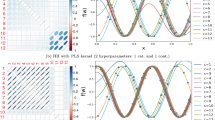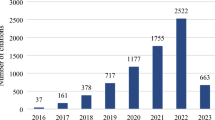Abstract
The response surface methodology (RSM), which uses a quadratic empirical function as an approximation to the original function and allows the identification of relationships between independent variables xi and dependent variables ys associated with multiple responses, stands out. The main contribution of the present study is to propose an innovative procedure for the optimization of experimental problems with multiple responses, which considers the insertion of uncertainties in the coefficients of the obtained empirical functions in order to adequately represent real situations. This new procedure, which combines RSM with the finite element (FE) method and the Monte Carlo simulation optimization (OvMCS), was applied to a real stamping process of a Brazilian multinational automotive company. For RSM with multiple responses, were compared the results obtained using the agglutination methods: compromise programming, desirability function (DF), and the modified desirability function (MDF). The functions were optimized by applying the generalized reduced gradient (GRG) algorithm, which is a classic procedure widely adopted in this type of experimental problem, without the uncertainty in the coefficients of independent factors. The advantages offered by this innovative procedure are presented and discussed, as well as the statistical validation of its results. It can be highlighted, for example, that the proposed procedure reduces, and sometimes eliminates, the need for additional confirmation experiments, as well as a better adjustment of factor values and response variable values when comparing to the results of RSM with classic multiple responses. The new proposed procedure added relevant and useful information to the managers responsible for the studied stamping process. Moreover, the proposed procedure facilitates the improvement of the process, with lower associated costs.
















Similar content being viewed by others
References
Prashar A (2016) A conceptual hybrid framework for industrial process improvement: integrating taguchi methods, shainin system and six sigma. Production Planning & Control 27:1389–1404
Silva AF, Marins FAS, Dias EX, Oliveira JBS (2019) Modeling the uncertainty in response surface methodology through optimization and monte carlo simulation: an application in stamping process. Materials & Design 173:107776
Prashar A (2016) Using shainin doe for six sigma: an Indian case study. Production Planning & Control 27:83–101
Montgomery DC (2009) Design and analysis of experiments. New York: Wiley Inc.
Babaki M, Yousefi M, Habibi Z, Mohammadi M (2017) Process optimization for biodiesel production from waste cooking oil using multi-enzyme systems through response surface methodology. Renew Energy 105:465–472
Yanga X, GSHZZM (2018) Application of design for six sigma tools in telecom service improvement. Production Planning & Control 29:959–971
Conway RT, Sangaline EW (2017) A monte carlo simulation approach for quantitatively evaluating keyboard layouts for gesture input. International Journal of Human-Computer Studies 99:37–47
Ye W, You F (2016) A computationally efficient simulation-based optimization method with region-wise surrogate modeling for stochastic inventory management of supply chains with general network structures. Comput Chem Eng 87:164–179
Marzouk M, Azab M, Metawie M (2018) Bim-based approach for optimizing life cycle costs of sustainable buildings. J Clean Prod 188:217–226
Gass S, Assad A (2005) Model world: tales from the time linedthe definition of or and the origins of monte carlo simulation. Interfaces 35:429–435
Xiao W, Wang B, Zhou J, Ma W, Yang L (2016) Optimization of aluminium sheet hot stamping process using a multi-objective stochastic approach. Eng Optim 48:2173–2189
Yoon T-J, Oh M-H, Shin H-J, Kang C-Y (2017) Comparison of microstructure and phase transformation of laser-weldedjoints in al-10wtstamping. Mater Charact 128:195–2022
Sun G, Zhang H, Wang R, Lv X, Li Q (2017) Multiobjective reliability-based optimization for crashworthy structures coupled with metal forming process. Struct Multidiscip Optim 56:1571–1587
Lampón JF, R-LE (2021) Modular product architecture implementation and decisions on production network structure and strategic plant roles. Production Planning & Control 0:1–16
Lampón JF, C-P G-BJ (2017) The impact of modular platforms on automobile manufacturing networks. Production Planning & Control 28:335–348
Zhang X, Zhu X, Wang C, Liu H, Zhou Y, Gai Y, Zhao C, Zheng G, Hang Z, Hu P, Ma Z-D (2018) Initial solution estimation for one-step inverse isogeometric analysisin sheet metal stamping. Computer methods in applied mechanics and engineering 330:629–645
Pimental AMF, Alves JLCM, Merendeiro NMS, Vieira DMF (2018) Comprehensive benchmark study of commercial sheet metal forming simulation softwares used in the automotive industry. Int J Mater Form 11:879–899
Bargmann S, Klusemann B, Markmann J, Schnabel JE, Schneider K, Soyarslan C, Wilmers J (2018) Generation of 3d representative volume elements forheterogeneous materials: a review. Prog Mater Sci 96:322–384
González C, Vilatela JJ, Molina-Aldareguía, Lopes CS, LLorca J (2017) Structural composites for multifunctional applications: Currentchallenges and future trends. Prog Mater Sci 89:194–251
Jadhav S, Martin S, Bruno B (2018) Applications of finite element simulation in the development of advanced sheet metal forming processe. erg- und hüttenmännische Monatshefte 163:109–118
Abosaf M, Essa K, Alghawail A, Tolipov A, Sul S, Pham D (2017) Optimisation of multi-point forming process parameters. International Journal Advanced manufucaturing Technology 92:1849–1859
Mori K, Matsubara H, Noguchi N (2004) Micro–macro simulation of sintering process bycoupling monte carlo and finite element methods. Int J Mech Sci 46:841–854
Ringuest JL (1992) Multiobjective optimization:behavioral and computational considerations. Boston College Chestnut Hill, MA 02167-3808 USA
Derringer S, Suich R (1980) Simultaneous optimization of several response variables. J Qual Technol 12:214–219
Ch’ng CK, Quah SH, Low HC (2005) A new approach for multiple-response optimization. Qual Eng 17:621–626
Tomaszewski R (2018) A comparative study of citations to chemical encyclopedias in scholarly articles: Kirk-othmer encyclopedia of chemical technology and ullmanns encyclopedia of industrial chemistry. Scientometrics 117:175–189
Gomes FM, Pereira FM, Silva AF, Silva MB (2019) Multiple response optimization: analysis of genetic programming for symbolic regression and assessment of desirability functions. Knowl-Based Syst 179:21–33
Chen X, Mei C, Xu B, Yu K, Huang X (2018) Quadratic interpolation based teaching-learning-based optimization for chemical dynamic system optimization. Knowl-Based Syst 145:250–263
Bertrand JWM, Fransoo JC (2002) Operations management research methodologies using quantitative modeling. International Journal of Operations and Production Management 22:241–264
Nayak MG, Vyas AP (2018) Optimization of microwave-assisted biodiesel production from papayaoil using response surface methodology. Renewble Energy 138:18–28
Goupy J, Creighton L (2007) Introduction to design of experiments with jpm examples, Third. SAS Institute Inc., Cary, NC, USA
Bobadilla MC, Lorza RL, García RE, Gómez FS, González EPV (2017) An improvement in biodiesel production from waste cooking oil by applying thought multi-response surface methodology using desirability functions. Energies 10:1– 20
Lawson JS (2010) Design and analysis of experiments with sds. Chapman & Hall
Papadrakakis M, Papadopoulos V (1996) Robust and efficient methods for stochastic finite element analysis using monte carlo simulation. Computer methods in applied mechanics and engineering 134:325–340
Hohe J, Paul H, Bechmann C (2018) A probabilistic elasticity model for long fiber reinforced thermoplastics with uncertain microstructure. Mech Mater 122:118–132
Durugbo C, Tiwari A, Alcock J (2013) Modelling information flow for organisations: a review of approaches and future challenges. Int J Inf Manag 33:597–610
Kroese DP, Taimre T, Botev ZI (2011) Handbook of monte carlo methods. Wiley, New York
Gentle JE (2003) Random number generation and monte carlo methods. Springer, New York
Sahinidis NV (2004) Optimization under uncertainty: state-of-the-art and opportunities. Computers & Chemical Engineering 28:971–983
Miranda RC, Montevechi JAB, Silva AF, Marins FAS (2014) A new approach to reducing search space and increasing efficiency in simulation optimization problems via the fuzzy-dea-bcc. Math Probl Eng 1:1–15
Shapiro A (2001) Monte carlo simulation approach to stochastic programming
Dehuri S, Cho S-B (2009) Multi-criterion pareto based particle swarm optimized polynomial neural network for classification: a review and state-of-the-art. Computer Science Review 3:19–40
Dey S, Mukhopadhyay T, Adhikari S (2017) Metamodel based high-fidelity stochastic analysis of composite laminates: a concise review with critical comparative assessment. Compos Struct 171:227–250
Boylan GL, Cho BR (2013) Comparative studies on the high-variability embedded robust parameter design from the perspective of estimators. Computers & Industrial Engineering 64:442–452
Kuriger GW, Grant FH (2011) A lexicographic nelder–mead simulation optimization method to solve multi-criteria problems. Computers & Industrial Engineering 60:555–565
Ehrgott M, Ide J, Schöbel (2014) Minmax robustness for multi-objective optimization problems. Eur J Oper Res 239:17–31
Zeleny A (1974) A concept of compromise solutions and the method of the displaced ideal. Comput Oper Res 1:479– 496
Kanellopoulos A, Gerdessen JC, Claassen GDH (2015) Compromise programming: non-interactive calibration of utility-based metrics. Eur J Oper Res 244:519–524
Jadidi O, Zolfaghari S, Cavalieri S (2015) A new normalized goal programming model for multi-objective problems: a case of supplier selection and order allocation. Int J Prod Econ 148:158–165
Saxena V, Kumar N, Saxena VK (2019) Multi-objective optimization of modified nanofluid fuel blends at different tio2 nanoparticle concentration in diesel engine: Experimental assessment and modeling. Appl Energy 248:330–353
ORACLE (2018) Optquest. www.oracle.com/technetwork/middleware/crystalball/overview/optquest-128316.pdf
Oracle (2018) How optquest works. www.docs.oracle.com/cd/E57185_01/CBOUG/ch02s03.html
Köksoy O, Doganaksoy N (2003) Joint optimization of mean and standard deviation using response surface methods. J Qual Technol 35:239–252
Patel SC, Graham JH, Ralston PAS (2008) Quantitatively assessing the vulnerability of critical information systems: a new method for evaluating security enhancements. Int J Inf Manag 28:483–491
Zhao K, Wang L, Chang Y, Yan J (2016) Identification of post-necking stressstrain curve for sheet metals by inverse method. Mech Mater 92:107–118
Bi S, Deng Z, Chen Z (2013) Stochastic validation of structural fe-models based on hierarchical clusteranalysis and advanced monte carlo simulation. Finite Elem Anal Des 67:22–333
Author information
Authors and Affiliations
Corresponding author
Ethics declarations
Ethics approval
This paper does not use data, which requires ethical approval, since all studies are done in a computational way. However, the main contribution of this article is to propose a new procedure that considers the insertion of uncertainties in the coefficients of the empirical functions in RSM with multiple responses, in practical experimental problems. It was possible to determine that RSM combined finite elements with Optimization via Monte Carlo Simulation (OvMCS) outperforms the use of (deterministic) optimization, using the generalized reduced gradient (GRG) algorithm, which is traditionally employed in RSM applications. Therefore, this paper does not directly involve people or biological information.
Additional information
Author contribution
The author Aneirson Silva was responsible for writing the article as well as programming in VBA-excel for the optimization multiobjectives problems and, also, for the statistical modeling of the data.
The author José Benedito was responsible for the writing of the article as well as the modeling and simulation by finite elements.
The author Fernando Marins was responsible for writing the article as well as for the final correction of the paper.
The author Erica Ximenes was responsible for writing the article and statistical and mechanical analysis.
Consent to participate and consent to publish
All authors are aware of their participation and also regarding the publication of this paper.
Prof. Aneirson Francisco da Silva
Prof. Fernando Augusto Silva Marins
Phd. Erica Ximenes Dias
Msc. José Benedito da Silva Oliveira
Competitive interests
I am submitting the article Multiple Response Optimization and Finite Element Method combined with Optimization via Monte Carlo Simulation in a stamping process under uncertainty. The main contribution of this article is to propose a new procedure that considers the insertion of uncertainties in the coefficients of the empirical functions in RSM with multiple answers, in practical experimental problems. This innovative procedure provides managers with useful information that will facilitate their work in seeking improvements in the analyzed printing process.
The main competitive interests are linked to companies that produce automotive components, since this system proposes an innovative way to analyze and improve stamping process problems.
Publisher’s note
Springer Nature remains neutral with regard to jurisdictional claims in published maps and institutional affiliations.
Electronic supplementary material
Below is the link to the electronic supplementary material.
Rights and permissions
About this article
Cite this article
da Silva, A.F., Marins, F.A.S., da Silva Oliveira, J.B. et al. Multi-objective optimization and finite element method combined with optimization via Monte Carlo simulation in a stamping process under uncertainty. Int J Adv Manuf Technol 117, 305–327 (2021). https://doi.org/10.1007/s00170-021-07644-9
Received:
Accepted:
Published:
Issue Date:
DOI: https://doi.org/10.1007/s00170-021-07644-9




